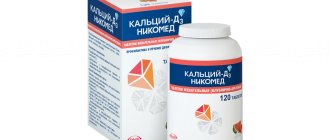Vitamin D successfully participates in thirty biochemical reactions that occur during human metabolism. Its presence is necessary in sufficient quantities throughout the entire calendar year, so a person who wants to stay healthy no longer has to wonder why vitamin D3 is needed.
There are two most useful forms:
- D2 (ergocalciferol), which enters the body with food (fatty fish, animal liver and kidneys, egg yolks, dairy products, butter, hard cheeses);
- D3 (cholecalciferol). It comes from food and is also synthesized in the body independently.
The importance of vitamin D plays an important role starting from birth, or rather, from the moment a person is conceived. The direct participation of the element in the metabolism of calcium and phosphorus, which, like “bricks”, build the child’s bone skeleton, is extremely important during the period of growth and formation. This is a real “protector” that prevents the risk of developing rickets in premature and weak newborn babies.
By taking vitamin D3, a child is almost 100% able to meet the need for the microelement in the body. This is especially important in the absence of breastfeeding (before complementary feeding). With the help of vitamin D, metabolic processes in cartilage, joint and bone tissues are supported throughout the entire period of life, and losses during menopause and with the onset of old age are compensated. The need for vitamin D is vital for both children and adults, pregnant and lactating women. This rule especially applies to regions with reduced solar activity and a small number of clear days.
The mechanism of formation of vitamin D3 is closely related to the absorption and production of ultraviolet radiation by human skin and exposure to air in open clothing.
Important! Exposure of an adult to the sun for about 6 hours in open clothing provides a daily dose of vitamin D of 10 mcg.
What role does vitamin D 3 play?
Cholecalciferol has a complex effect:
- activates the growth and division of cellular structures;
- normalizes metabolism;
- supports the functioning of the heart muscle;
- reduces high blood pressure;
- promotes better absorption of calcium and phosphorus;
- has a positive effect on the condition of bones, hair, nails;
- stimulates the nervous, endocrine, digestive systems;
- regulates the level of male and female hormones;
- strengthens weakened immunity;
- provides full reproductive function;
- increases mental and physical endurance;
- allows you to maintain normal weight;
- relieves insomnia and improves sleep quality.
When taken in the required amount, the vitamin helps prevent the development of many pathologies. Among them are heart attacks, strokes, psoriasis, visual impairment, rheumatism, osteochondrosis, arthritis, oncology, senile dementia, and Alzheimer's disease.
Optimal levels of the vitamin compound are of utmost importance for a successful pregnancy. Cholecalciferol promotes the birth of a full-term baby with good weight, without any serious abnormalities. It also helps women recover safely after childbirth.
Sources of vitamin D 3
It is possible to obtain a useful component from certain types of food. These include fairly high-calorie foods:
- beef liver,
- egg yolks,
- natural butter,
- hard cheese,
- fatty fish (mostly caught at sea),
- cow and goat milk,
- homemade sour cream,
- Red caviar,
- corn oil,
- nuts.
The leader in its content is fish oil, which also contains other valuable components (minerals, essential Omega-6 acids).
Attention! For complete vitaminization, you need to eat the above foods regularly and in large quantities. This is not always feasible, and also goes against the principles of dietary nutrition.
The vitamin is produced in the skin under exposure to the sun. To start its production, you need to sunbathe under direct rays for at least 20-30 minutes a day. Daily sunbathing helps to avoid vitamin deficiency.
Not every person has the ability to receive D3 naturally. Taking specially formulated supplements can help avoid a deficiency of this essential compound. To obtain maximum benefit, you must strictly follow the instructions or prescriptions of the doctor who prescribed fortification.
Scientific fact! Repeated studies have confirmed that there is an acute deficiency of vitamin D3 among the adult population. Many residents of Russia suffer from its shortage and related violations, including those who live in the sunniest places (Crimea, Krasnodar Territory). This problem can be solved with the help of a course of taking fortified products. It has been proven that such products provide no less effect than exposure to sunlight and eating natural food.
what vitamin d 3 to buy
D3-CAPS 5,000 IU
The medicine is taken orally with meals. Prevention and treatment of vitamin D deficiency in adults and adolescents (from 12 to 18 years old)
.
— The prophylactic dose of vitamin D is determined individually by the doctor, taking into account age, intake of vitamin D from other sources (food, insolation), overweight (obesity) of the patient, taking medications that affect the metabolism of vitamin D. Typically the recommended dose is 500-1000 IU vitamin D per day. — The therapeutic dose of vitamin D and the duration of treatment are determined individually by the doctor, taking into account the initial severity of vitamin D deficiency, laboratory confirmed, age, intake of vitamin D from other sources (food, insolation), overweight (obesity) of the patient, taking medications that affect on the metabolism of vitamin D. Usually the recommended dose is 5,000 - 6,000 IU of vitamin D per day. Duration of treatment is up to 6–8 weeks, followed by laboratory monitoring of the concentration of 25-hydroxycholecalciferol in the blood and a decision on whether to continue taking it or switch to taking a prophylactic dose. As an adjunct to specific therapy for osteoporosis in patients at risk of vitamin D deficiency:
the recommended dose of vitamin D is 1000 IU daily or a weekly dose of 7000 IU or an alternative monthly dose of 50,000 IU.
For older patients, who are particularly at risk for falls and fractures, a dose equivalent to 2000 IU of vitamin D per day is recommended. Patients should receive supplemental calcium if dietary intake is insufficient. Certain groups of the population are at high risk of vitamin D deficiency, and therefore higher doses and monitoring of serum 25-hydroxycholecalciferol concentrations may be required for these groups: - persons suffering from alcoholism; — institutionalized or hospitalized persons; - dark-skinned; - patients with diseases of the hepatobiliary system - impaired liver function, cirrhosis, obstructive jaundice; - patients with malabsorption, including those suffering from inflammatory bowel disease, persistent diarrhea and celiac disease; - obese patients; — patients with diagnosed osteoporosis; - patients using concomitant medications (for example, anticonvulsants, glucocorticoids); - persons with limited exposure to the sun, including children. To make it easier to select the dose of vitamin D3, it is recommended to use medications with different dosages (500 IU, 2,000 IU, 5,000 IU, 50,000 IU). Dosage for liver failure
No dose adjustment is required.
Dosage in Renal Impairment
Vitamin D should not be used in patients with severe renal impairment.
Infants and Children
(0 - 12 years) Not recommended for children under 12 years of age.
Old age
In old age, the need for vitamin D may increase due to a decrease in the absorption of vitamin D, a decrease in the ability of the skin to synthesize provitamin D, a decrease in sun exposure, and an increase in the incidence of renal failure. The dose of treatment for vitamin D deficiency in older people is determined individually by the doctor, depending on the course and severity of the disease.
TOP best drugs by release form
Cholecalciferol is present in most multivitamin complexes, but it is best to take it in the form of monopreparations (single-component). It is especially important to choose such products if a significant lack of D 3 is detected. Fortified products should be used not only in the winter, but also in the warm season.
The vitamin is available in three main varieties:
- pills;
- capsules;
- liquid solutions.
Below is a detailed description of what advantages each of the dosage forms has, which is worth considering when choosing which one is best to buy vitamin D 3 for an adult .
Vitamin D3 tablets
In many modern pharmacies you can find vitamin D 3, presented in tablet form. This is a traditional version containing a dry crystalline ingredient and auxiliary components.
Tablet medications have a number of advantages, thanks to which many buyers choose them:
- ease of use;
- maximum dosing accuracy;
- long shelf life.
The tablets are convenient to carry with you and take on trips and trips. They do not require special storage conditions.
Tablet drugs are among the medications that require mandatory breakdown. As a rule, this process takes at least 20-25 minutes. Only after this the components included in the product are sent to the intestines, where they can be fully absorbed and provide all the benefits due.
There are various options for vitamin supplements on sale. You can purchase regular tablets, which are recommended to be taken with a sufficient amount of water, chewable ones, which do not require the use of liquid, and water-soluble (effervescent) tablets.
For your information! Tablet preparations with vitamin D 3 often contain dyes and flavoring additives, which may be of synthetic origin. In particularly sensitive people, such components can provoke an allergic reaction.
Vitamin D3 capsules
The drug, presented in capsules, has the same degree of effectiveness as other options. This product has certain advantages:
- has a shell that completely dissolves in gastric juice;
- does not cause discomfort during swallowing;
- compact, can be used in any conditions.
After the capsule dissolves in the stomach, all substances contained in it retain their activity. Such drugs have an important feature - if a person has difficulty swallowing a pill, it can be easily opened and the powdery contents taken out. It is much easier to use if you have problems swallowing.
capsulated vitamin D 3 in a pharmacy for an adult - it is rare. This is one of the main disadvantages of such medications. There is also another drawback - higher cost, which is why many buyers choose other options for vitamin products.
Note! The capsules are equipped with a gelatin shell. The presence of such a component does not allow people suffering from certain types of allergies to take them. Gelatin often contains components of animal origin, so it is not suitable for vegetarians.
Vitamin D3 in liquid form
The vitamin is often offered to customers in the form of drops. Such drugs can have two base options:
- water;
- oil
The liquid product has many positive aspects. It is absorbed best and begins to act several times faster than capsules or tablets. According to the instructions, vitamin D 3 drops are easy and convenient to use. There are no difficulties with swallowing during its use.
There is another important plus. As a rule, liquid formulations do not have a specific medicinal taste. Basically, they are completely tasteless, do not taste bitter and lack the specific aroma characteristic of many solid medicines. This effect is achieved due to the presence of special corrective substances, which are much easier to add to the liquid.
Solutions have some disadvantages. The main disadvantage is that the shelf life is shorter than that of pills. In addition, such drugs often require more complex storage, compliance with certain conditions of temperature and humidity.
Must be taken into account! Liquid formulations are mainly prescribed to patients who have been diagnosed with severe hypovitaminosis (lack of vitamin substances). Such drugs are also included in the complex therapy of various diseases of the musculoskeletal system.
What dosage to choose
The volume of cholecalciferol is calculated in micrograms (mcg). If you plan to take vitamin D3 for preventive or therapeutic purposes, you should choose products with a convenient dosage.
Today you can buy vitamin D 3 in the following options:
- tablets – 15 mcg, 25 mcg;
- capsules – 25 mcg, 20 mcg;
- solutions – 30 ml, 50 ml (2.5 mcg in each drop).
The exact amount of vitamin D 3 required by an adult is determined by his condition and gender. If cholecalciferol is taken for preventive purposes, the following dosage regimen is relevant:
| Patient category | Daily dose of vitamin D 3 |
| Men | 10-15 mcg |
| Women | 10-15 mcg |
| Pregnant women | 15 mcg |
| Women during menopause, menopause | 15-20 mcg |
| Aged people | 15 mcg |
To prevent vitamin deficiency and related disorders, vitamin D 3 is taken 1-2 times a week. In the absence of serious pathologies, this amount is sufficient for the normal functioning of phosphorus-calcium metabolism and other vital processes. Sometimes daily intake of cholecalciferol is indicated. If necessary, the patient may be offered a different regimen for using the drug, related to certain characteristics of the body.
In old age, the need for vitamin D3 often increases. This is due to a reduction in the absorption of cholecalciferol, a decrease in the ability of the skin to synthesize such a substance during insolation, existing kidney problems, and a predisposition to the development of osteoporosis and other joint diseases.
If cholecalciferol is prescribed for medicinal purposes, the dosage is determined individually, taking into account the existing disease. Before starting the course, the patient is given a test to determine the level of vitamin content in the body. This allows you to avoid overdose, which can cause undesirable symptoms such as indigestion, loss of appetite, skin rashes, and increased nervousness.
Important point! The duration of use of vitamin D 3 should be determined by the doctor. The average course duration is from four weeks to three months. Repeated appointments must be coordinated with a medical specialist.
Risk factors for the development of vitamin deficiency
Let's look at the main reasons why vitamin deficiency may occur:
- Vegetarianism, dieting.
- Limited exposure to sunlight.
- Dark skin color.
- Limited sleep, night shifts.
- Living in environmentally unsafe areas.
- Chronic gastrointestinal diseases.
If we take into account possible dietary errors and infrequent exposure to the sun, it becomes clear that there is a risk of vitamin D deficiency in a large percentage of people (both children and adults).
What to take with
The vitamin is used in accordance with the rules that allow you to get the maximum benefit from it. Doctors give the following recommendations:
- Consume fortified products in the first half of the day (preferably in the morning).
- Drink the product some time after breakfast (30-40 minutes).
- Take with liquid (pure still water).
Cholecalciferol is fat soluble. For this reason, many doctors advise eating high-calorie foods before taking it. Food containing enough fat promotes faster and more efficient absorption.
Need to know! The vitamin should not be taken simultaneously with certain pharmacological products (sodium fluoride, hetracyclinone). If the above-mentioned medications are prescribed by a medical specialist, the interval should be at least two to three hours. It is unsafe to take cholecalciferol together with cardiac glycosides and antacids. It is undesirable to combine it with high doses of vitamin E and other forms of D3.
There are some disorders in which taking cholecalciferol is completely contraindicated. These include pathological conditions - severe renal failure, nephrolithiasis (presence of kidney stones), hypervitaminosis, nephrocalcinosis (deposition of calcium salts in the kidney tissue), hypercalcemia (increased concentration of calcium in the blood serum). Also, the vitamin compound should not be taken if you have an individual intolerance (allergic reaction).
Contraindications for use
Let's consider the factors under which you should not additionally drink drugs containing ergocalciferol or cholecalciferol:
- individual intolerance, allergic manifestations;
- excess calcium and phosphorus;
- chronic diseases of the cardiovascular system, gastrointestinal tract in acute form;
- pulmonary tuberculosis;
- uncontrolled use;
- violation of metabolic processes;
- decreased immunity.
You cannot combine the use of vitamin D with calcium single preparations containing this substance, as well as with medications containing phosphorus in any form. Proper use in compliance with the dosage gives a lasting result.



